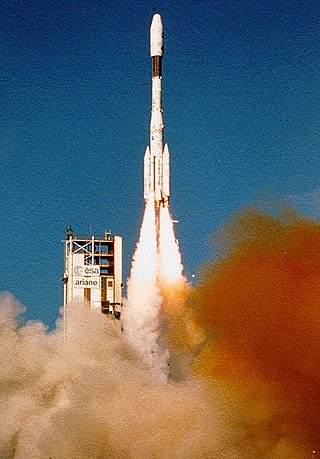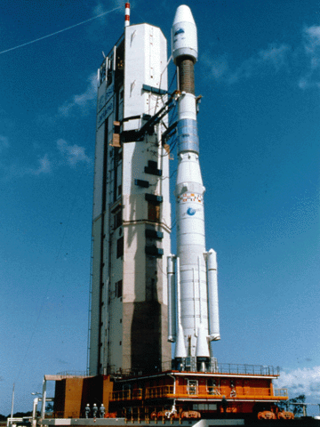
Ariane 5 is a retired European heavy-lift space launch vehicle developed and operated by Arianespace for the European Space Agency (ESA). It was launched from the Centre Spatial Guyanais (CSG) in French Guiana. It was used to deliver payloads into geostationary transfer orbit (GTO), low Earth orbit (LEO) or further into space. The launch vehicle had a streak of 82 consecutive successful launches between 9 April 2003 and 12 December 2017. Since 2014, Ariane 6, a direct successor system, is in development.

Energia was a 1980s super-heavy lift launch vehicle. It was designed by NPO Energia of the Soviet Union as part of the Buran program for a variety of payloads including the Buran spacecraft. Control system main developer enterprise was the Khartron NPO "Electropribor". The Energia used four strap-on boosters each powered by a four-chamber RD-170 engine burning kerosene/LOX, and a central core stage with four single-chamber RD-0120 (11D122) engines fueled by liquid hydrogen/LOX.

Ariane is a series of European civilian expendable launch vehicles for space launch use. The name comes from the French spelling of the mythological character Ariadne. France first proposed the Ariane project and it was officially agreed upon at the end of 1973 after discussions between France, Germany and the UK. The project was Western Europe's second attempt to develop its own launcher following the unsuccessful Europa project. The Ariane project was code-named L3S.

The Centaur is a family of rocket propelled upper stages that has been in use since 1962. It is currently produced by U.S. launch service provider United Launch Alliance, with one main active version and one version under development. The 3.05 m (10.0 ft) diameter Common Centaur/Centaur III flies as the upper stage of the Atlas V launch vehicle, and the 5.4 m (18 ft) diameter Centaur V is being developed as the upper stage of ULA's new Vulcan rocket. Centaur was the first rocket stage to use liquid hydrogen (LH2) and liquid oxygen (LOX) propellants, a high-energy combination that is ideal for upper stages but has significant handling difficulties.

The Ariane 4 was a European expendable launch vehicle, developed by the Centre national d'études spatiales (CNES), the French space agency, for the European Space Agency (ESA). It was manufactured by ArianeGroup and marketed by Arianespace. Since its first flight on 15 June 1988 until the final flight on 15 February 2003, it attained 113 successful launches out of 116 total launches.

The Polar Satellite Launch Vehicle (PSLV) is an expendable medium-lift launch vehicle designed and operated by the Indian Space Research Organisation (ISRO). It was developed to allow India to launch its Indian Remote Sensing (IRS) satellites into Sun-synchronous orbits, a service that was, until the advent of the PSLV in 1993, only commercially available from Russia. PSLV can also launch small size satellites into Geostationary Transfer Orbit (GTO).

Proton is an expendable launch system used for both commercial and Russian government space launches. The first Proton rocket was launched in 1965. Modern versions of the launch system are still in use as of 2023, making it one of the most successful heavy boosters in the history of spaceflight. The components of all Protons are manufactured in the Khrunichev State Research and Production Space Center factory in Moscow and Chemical Automatics Design Bureau in Voronezh, then transported to the Baikonur Cosmodrome, where they are assembled at Site 91 to form the launch vehicle. Following payload integration, the rocket is then brought to the launch pad horizontally by rail, and raised into vertical position for launch.

The Angara rocket family is a family of launch vehicles being developed by the Moscow-based Khrunichev State Research and Production Space Center. The launch vehicles are to put between 3,800 kg (8,400 lb) and 24,500 kg (54,000 lb) into low Earth orbit and are intended, along with Soyuz-2 variants, to replace several existing launch vehicles.
Delta III was an expendable launch vehicle made by McDonnell Douglas. The vehicle was developed from the highly-successful Delta II to help meet the launch demand of larger satellites. The first Delta III launch was on August 26, 1998. Of its three flights, the first two were failures, and the third, though declared successful, reached the low end of its targeted orbit range and carried only a dummy (inert) payload. The Delta III could deliver up to 3,810 kg (8,400 lb) to geostationary transfer orbit, twice the payload of its predecessor, the Delta II. Under the four-digit designation system from earlier Delta rockets, the Delta III is classified as the Delta 8930.

Geosynchronous Satellite Launch Vehicle (GSLV) is a class of expendable launch systems operated by the Indian Space Research Organisation (ISRO). GSLV has been used in fifteen launches since 2001.
A liquid rocket booster (LRB) uses liquid fuel and oxidizer to give a liquid-propellant or hybrid rocket an extra boost at take-off, and/or increase the total payload that can be carried. It is attached to the side of a rocket. Unlike solid rocket boosters, LRBs can be throttled down if the engines are designed to allow it, and can be shut down safely in an emergency for additional escape options in human spaceflight.

The Launch Vehicle Mark-3 or LVM3 is a three-stage medium-lift launch vehicle developed by the Indian Space Research Organisation (ISRO). Primarily designed to launch communication satellites into geostationary orbit, it is also due to launch crewed missions under the Indian Human Spaceflight Programme. LVM3 has a higher payload capacity than its predecessor, GSLV.
The VLS-1 was the Brazilian Space Agency's main satellite launch vehicle. The launch vehicle was to be capable of launching satellites into orbit. The launch site was located at the Alcântara Launch Center due to its proximity to the equator.

The VLM is a proposed three-stage satellite launcher being developed by the Brazilian General Command for Aerospace Technology in collaboration with Germany. The project originated in 2008 as a simplified version of the VLS-1 rocket, using only the core stages. The first launch is currently planned for no earlier than 2023.

Ariane 6 is a European expendable launch system under development since the early 2010s by ArianeGroup on behalf of the European Space Agency (ESA). It replaces the Ariane 5, as part of the Ariane launch vehicle family. The stated motivation for Ariane 6 was to halve the cost compared to Ariane 5, and increase the capacity for the number of launches per year.

Adeline was a concept for a reusable rocket first-stage that would fly itself back to Earth after a launch using drone technology for horizontal landing on a runway. Airbus Defence and Space conceived the design concept.

A super heavy-lift launch vehicle is a rocket that can lift to low Earth orbit a "super heavy payload", which is defined as more than 50 metric tons (110,000 lb) by the United States and as more than 100 metric tons (220,000 lb) by Russia. It is the most capable launch vehicle classification by mass to orbit, exceeding that of the heavy-lift launch vehicle classification.
New Glenn is a heavy-lift orbital launch vehicle in development by Blue Origin, named after NASA astronaut John Glenn, the first American astronaut to orbit Earth. Design work on the vehicle began in 2012; illustrations of the vehicle, and the high-level specifications, were initially publicly unveiled in September 2016. New Glenn is a two-stage rocket with a diameter of 7 m (23 ft). Its first stage will be powered by seven BE-4 engines that are also being designed and manufactured by Blue Origin.

During the lifetime of the Space Shuttle, Rockwell International and many other organizations studied various Space Shuttle designs. These involved different ways of increasing cargo and crew capacity, as well as investigating further reusability. A large focus of these designs were related to developing new shuttle boosters and improvements to the central tank, but also looked to expand NASA's ability to launch deep space missions and build modular space stations. Many of these concepts and studies would shape the concepts and programs of the 2000s such as the Constellation, Orbital Space Plane Program, and Artemis program.
The Next Generation Launch Vehicle or NGLV is a three-stage partially reusable rocket, currently under development by the Indian Space Research Organisation (ISRO). This vehicle is designed to replace currently operational systems like PSLV, GSLV and LVM3.



















